 |
|||||||||
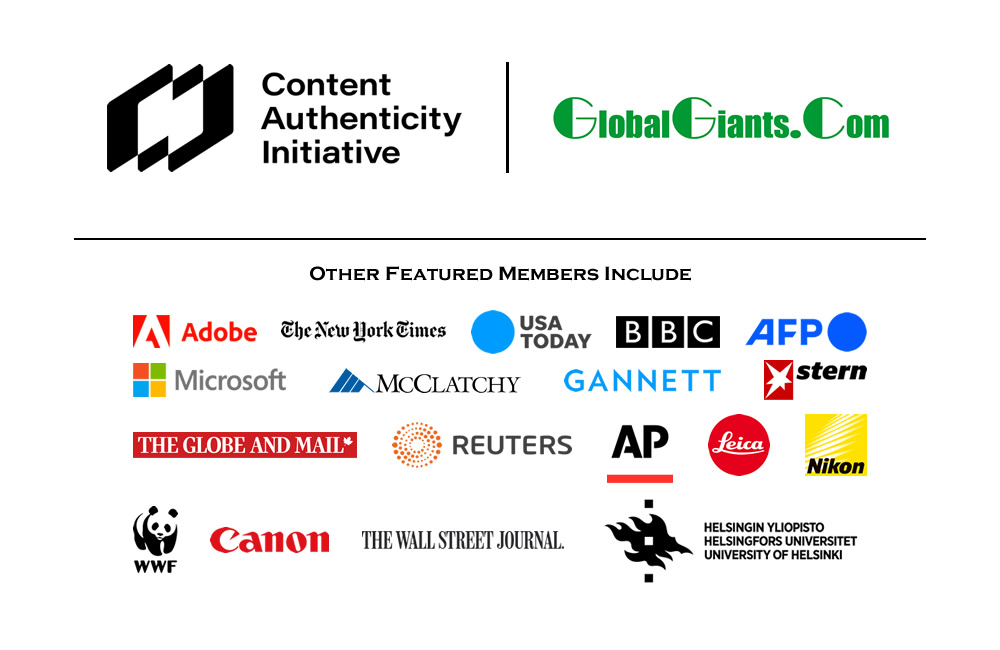



 |
|||||||||




Funded by Rockefeller Family and Tiffany Foundation, Around the Americas project demonstrates global warming and climate change impacts on the environments and ecosystems, its Ocean Watch crew departs Barrow, hopes for a safe journey through the ice encrusted Amundsen Gulf.
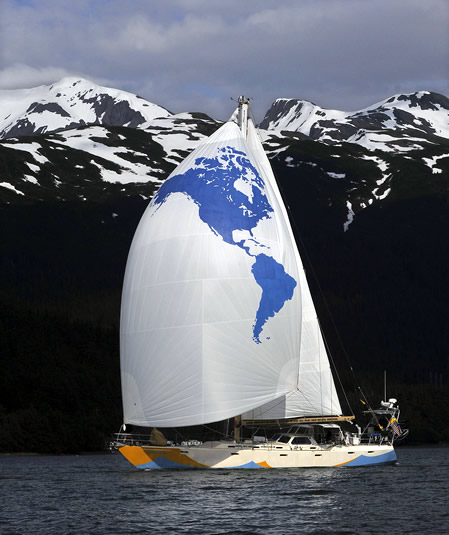
Photo: 64-foot Ocean Watch makes its way into the Northwest Passage on the first part of a 25,000 mile ocean conservation expedition around North and South America.
After eight weeks at sea following its departure on May 31 from Seattle, the crew of Ocean Watch - the 64-foot steel-hulled sailboat - representing the 13 month- long Around the Americas expedition has turned east into the ice-filled Northwest Passage after traveling a predominantly northerly course.
The expedition is focused on the realities of global warming and climate change. Captain Mark Schrader describes in the latest Captain's Log what the boat and crew face as they enter the Northwest Passage.
"(Sunday) at 0745 the anchor was up and Ocean Watch headed to Point Barrow, approximately 8nm to the north. At Point Barrow we make a sharp turn east, exit the Chukchi Sea, enter the Beaufort Sea and finally point our bow into the Northwest Passage. With Cambridge Bay roughly 1050nm (nautical miles) due east and still blocked by ice in Amundsen Gulf. We'll make several stops along the way while waiting for the forecast mid-August breakup.
"The next community with a sheltered harbor, fuel and services with enough depth for OW [Ocean Watch] is Tuktoyaktuk (Tuk), 490nm down the line. All of our ice reports indicate the passage from here to Tuk is currently open. The predicted winds for the next few days should keep the ice away from the shore and leave plenty of room for us. If the conditions change we have some options; Thetis Island, Stockton Island, Kaktovik and Herschel Island can all afford some protection from wind and ice. Herschel Island with its long and rich whaling and over-wintering-for-stranded-sailors-history is on our 'must visit' list."
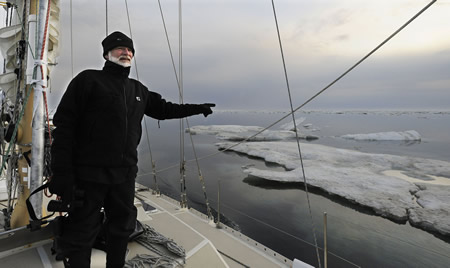
Photo: Captain Mark Schrader, leader of the 25,000 mile ocean conservation project Around the Americas, gives steering directions through the ice in the Northwest Passage.
Ocean Watch is carrying the message of the Around the Americas expedition that the oceans surrounding North and South America are very fragile and we need to be aware of the problems and make changes in our lives to help correct them. Led by Captain Mark Schrader, the first American to solo circumnavigate the earth via the five southern capes, the 25,000-mile voyage will be one of only about 100 boats to have travelled through the Northwest Passage in the past 100 years.
Schrader continues in the Log, "Writing this was just interrupted by a whale sighting off the bow, then a Polar Bear sighting on the beach. The beach is a little less than 1/3 nm away, the bear appears to be sleeping. The helmsperson also just announced we're finally turning east. Ocean Watch hasn't sailed an easterly course since leaving Seattle, some 3,400nm and 8-weeks ago. This is a significant waypoint for us - we're now truly going 'over the top' and into the Passage."
With a permanent crew of four experienced sailors, a scientist and educator on board, Ocean Watch will traverse the treacherous frozen waters of the Northwest Passage for the next four to six weeks making scientific observations and collecting information.
Around the Americas is a 25,000-mile clockwise-circumnavigation of the North and South American continents, never before undertaken in continuous fashion. The sailboat, equipped with some of the latest technology, along with scientists and educators who join during various legs of the voyage, is making 31 stopovers in 13 months to draw attention to the changing condition of the oceans. With major funding support from Tiffany & Co. Foundation, a non-profit consortium has been formed to make the public more aware of the plight of the oceans.
Source: Around the Americas
|GlobalGiants.com|
Edited & Posted by the Editor | 10:46 AM | View the original post
Hilton Hotel & Suites Niagara Falls Fallsview Opens its Doors on Major Expansion.

Photo: The Hilton Hotel & Suites Niagara Falls-Fallsview has changed the skyline in Niagara Falls, Canada. As Canada's tallest hotel tower, the Hilton Hotel & Suites rises 500 meters (more than 5 football fields) over the thundering Falls.
After months of construction and anticipation, Canada's tallest hotel tower has opened its doors and forever changed the skyline in Niagara Falls, Canada. With the best views, the new Hilton Hotel & Suites Niagara Falls - Fallsview rises 500 meters (more than 5 football fields) over the thundering Falls.
The Hilton Hotel & Suites began its transformation to become the tallest hotel tower in Canada in January 2007. Now the largest resort in Niagara Falls, it boasts over 1,000 hotel rooms and suites, including two spectacular Presidential Suites on the 52nd Floor. Each elegantly appointed 2-bedroom suite features a sitting room with a fireplace, magnificent city or falls views and wireless technology.
Source: Hilton Hotel & Suites Niagara Falls Fallsview
|GlobalGiants.com|
Edited & Posted by the Editor | 10:06 AM | View the original post

U.S. News Media Group today announced the 2009-10 publication of America's Best Hospitals, accessible today online and on sale at newsstands Tuesday, July 21.
Now in its 20th year, the multi-platform 2009-10 America's Best Hospitals guide is the most extensive hospital ranking to-date. It includes rankings of 174 medical centers nationwide in 16 specialties -- with full data available online for another 1,500 unranked hospitals. In addition, the Best Hospitals "Honor Roll" highlights 21 medical centers that were ranked at or near the top in at least six specialties.
The 16 ranked specialties are cancer; diabetes & endocrine disorders; digestive disorders; ear, nose, and throat; geriatric care; gynecology; heart and heart surgery; kidney disorders; neurology and neurosurgery; ophthalmology; orthopedics; psychiatry; rehabilitation; respiratory disorders; rheumatology; and urology.

"When the stakes are high, you want the best care you can get for someone close to you," said Avery Comarow, health rankings editor. "These are hospitals that are used to getting the sickest patients."
The 2009-10 Best Hospitals guide also includes a web video series on USNews.com where visitors can watch HealthiNation Chief Medical Editor Dr. Holly Atkinson interview Comarow and Dr. Bernadine Healy, U.S. News health editor, to capture their expertise and insight into the Best Hospitals ranking process. The videos take viewers behind the scenes of the rigorous selection process, include profiles of top winners across categories, and reveal what it takes for a hospital to be named one of "America's Best."
"Over the past two decades, America's Best Hospitals has proven to be an essential resource for consumers facing difficult healthcare decisions," said Brian Kelly, editor of U.S. News & World Report.


Of the medical centers ranked in the 2009-10 America's Best Hospitals, 21 earned Honor Roll status, demonstrating excellence and breadth of expertise by ranking at or near the top in at least six specialties.
The top hospitals in the 2009-10 Honor Roll are:
1. Johns Hopkins Hospital, Baltimore
2. Mayo Clinic, Rochester, Minn.
3. Ronald Reagan UCLA Medical Center, Los Angeles
4. Cleveland Clinic
5. Massachusetts General Hospital, Boston
6. New York-Presbyterian University Hospital of Columbia and Cornell
7. University of California, San Francisco Medical Center
8. Hospital of the University of Pennsylvania, Philadelphia
9. Barnes-Jewish Hospital/Washington University, St. Louis
10. Brigham and Women's Hospital, Boston
10. Duke University Medical Center, Durham, N.C.
12. University of Washington Medical Center, Seattle
13. UPMC-University of Pittsburgh Medical Center
14. University of Michigan Hospitals and Health Centers, Ann Arbor
15. Stanford Hospital and Clinics, Stanford, Calif.
16. Vanderbilt University Medical Center, Nashville
17. NYU Medical Center, New York
17. Yale-New Haven Hospital, New Haven, Conn.
19. Mount Sinai Medical Center, New York
20. Methodist Hospital, Houston
21. Ohio State University Hospital, Columbus
In addition to the hospitals that appear in one or more specialty rankings in the print magazine, the 2009-10 America's Best Hospitals package includes an online consumer guide where readers can find information on more than 1,500 hospitals that qualified for rankings, but did not score high enough to be ranked.
Source: U.S. News Media Group
|GlobalGiants.com|
"The very first requirement in a hospital is that it should do the sick no harm."
-- Florence Nightingale
Edited & Posted by the Editor | 11:05 PM | View the original post
The 2009 G8 Summit is being held in L'Aquila, Italy, from 8 to 10 July. The main issues on the Italian Presidency's agenda are the economic crisis and a boost to growth, relaunching international trade, welfare policies, climate changes, development in the poor countries and in Africa, food security and safety, access to water, health, and the resolution of regional crises.
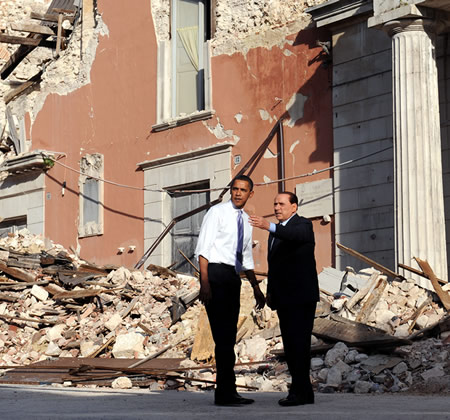
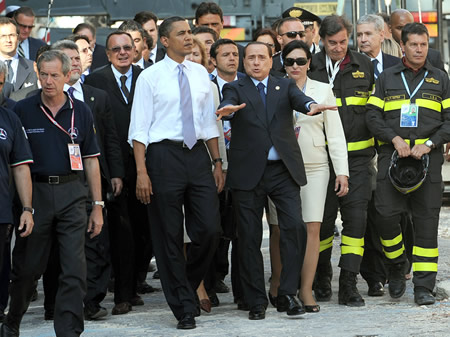
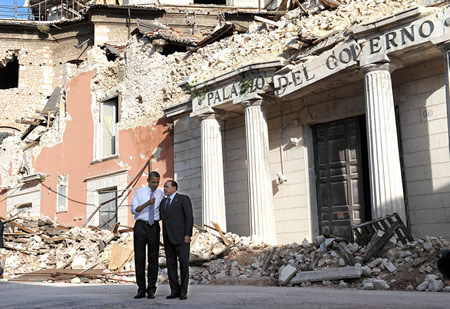
Photos: July 8, 2009, first day of the G8 Summit in L'Aquila. Italian Prime Minister Silvio Berlusconi and US President Barack Obama while visiting the historical center of L'Aquila destroyed by the earthquake of 6 April. Ansa photos: Maurizio Brambatti
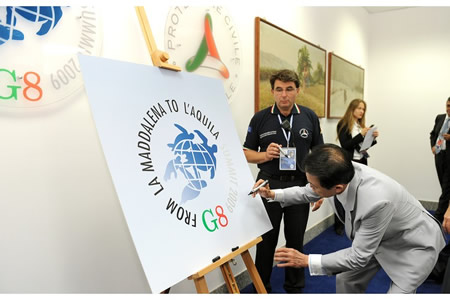
Photo: Japanese Prime Minister Taro Aso, signs the G8 logo plaque on the first day of the G8 Summit in L'Aquila. ANSA Photo: Ettore Ferrari
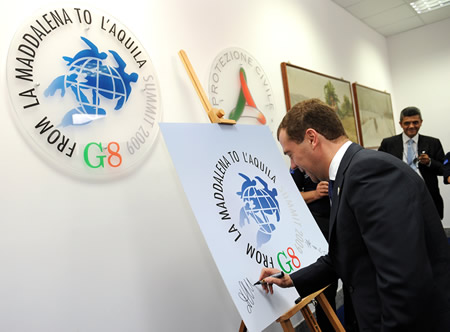
Photo: The President of the Russian Federation , Dmitry Medvedev, signs the G8 logo plaque on the first day of the G8 Summit in L'Aquila. ANSA Photo: Ettore Ferrari
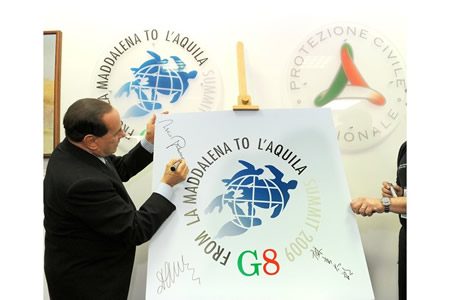
Photo: Italian Prime Minister Silvio Berlusconi, signs the G8 logo plaque on the first day of the G8 Summit in L'Aquila. ANSA Photo: Ettore Ferrari
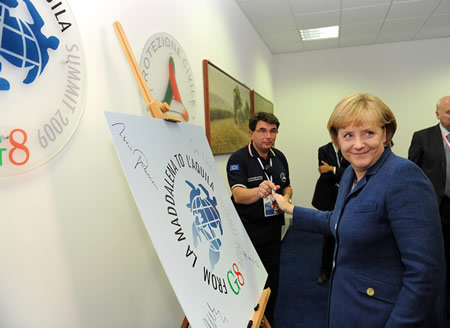
Photo: German Chancellor, Angela Merkel , signs the G8 logo plaque on the first day of the G8 Summit in L'Aquila. ANSA Photo: Ettore Ferrari
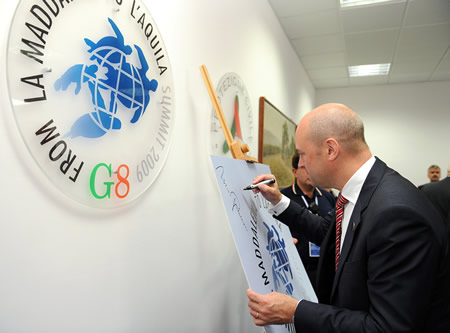
Photo: Swedish Prime Minister, Fredrik Reinfeldt, signs the G8 logo plaque on the first day of the G8 Summit in L'Aquila. ANSA Photo: Ettore Ferrari
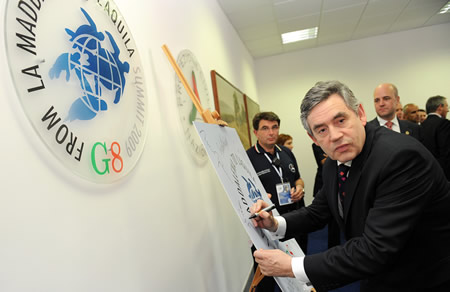
Photo: British Prime Minister Gordon Brown, signs the G8 logo plaque on the first day of the G8 Summit in L'Aquila. ANSA Photo: Ettore Ferrari
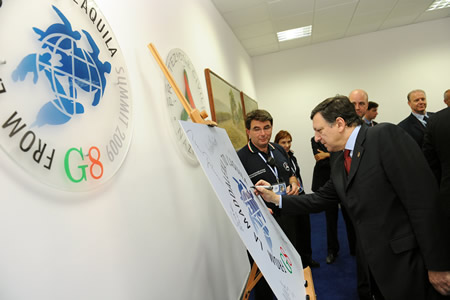
Photo: The EU Commission President, Manuel Barroso, signs the G8 logo plaque on the first day of the G8 Summit in L'Aquila. ANSA Photo: Ettore Ferrari
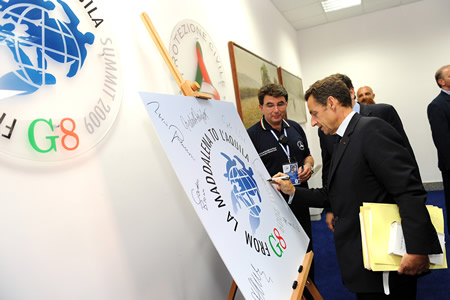
Photo: French President, Nicolas Sarkozy, signs the G8 logo plaque on the first day of the G8 Summit in L'Aquila. ANSA Photo: Ettore Ferrari
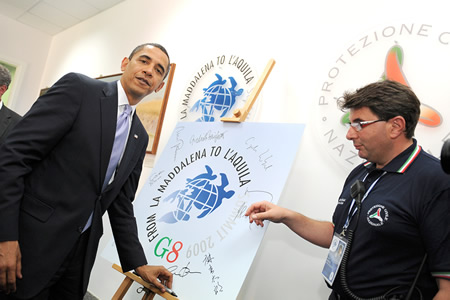
Photo: The President of United State, Barack Obama, signs the G8 logo plaque on the first day of the G8 Summit in L'Aquila. ANSA Photo: Ettore Ferrari
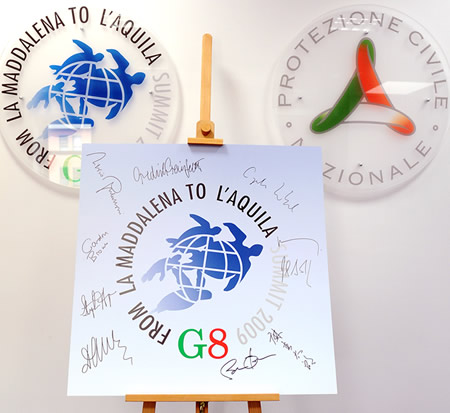
Photo: The G8 logo plaque with all the leaders' signatures, on the first day of the G8 Summit in L'Aquila. ANSA Photo: Ettore Ferrari
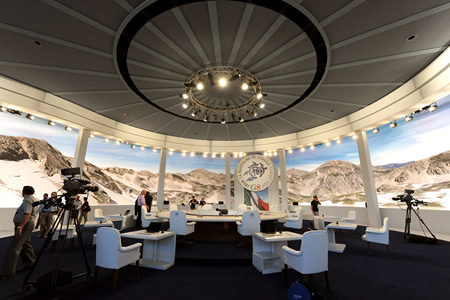
Photo: The interior of the Main Conference hall, where the Summit meetings are to be carried out in the premises of the Coppito Guardia di Finanza campus. Photo taken on 7 July 2009, the eve of the G8 Summit. ANSA Photo: Ettore Ferrari
|GlobalGiants.com|
Edited & Posted by the Editor | 10:19 AM | View the original post
42% increase short-term holdings; most move to more conservative vehicles.
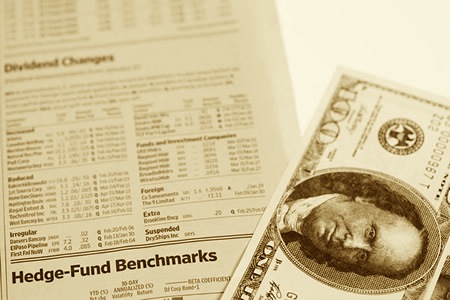
With little easing in access to credit, U.S. organizations are continuing to stockpile cash, according the Association for Financial Professionals' 2009 Liquidity Survey. Almost three-quarters (72%) of companies had increased or maintained their U.S. cash balances during the first part of 2009.
According to the new AFP survey, 42% of organizations increased their U.S. cash and short-term investment balances between December 2008 and May 2009, while 30% saw no significant change in short-term cash balances. More than a quarter (28%) of organizations saw their U.S. cash and short-term investment balances deteriorate over the six-month period. Organizations with non-investment grade ratings were more likely to have seen their cash and short-term investment balances shrink.
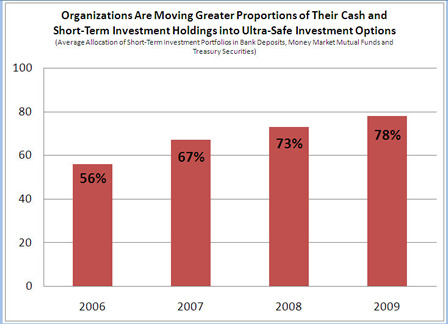
"Despite unprecedented government action, the lack of any significant thaw in short-term credit access is extremely troubling and many companies are reacting by stockpiling cash," said Jim Kaitz, President and CEO of AFP. "While, many organizations with their strong cash positions will be well-positioned once the economy begins to improve, overall economic conditions will not improve until organizations can begin using their cash in activities that foster growth."
The fourth annual AFP 2009 Liquidity Survey was underwritten by The Bank of New York Mellon.

Despite reports of an easing in the corporate credit markets, over half (59%) of respondents indicated that their organizations' access to short-term credit had not changed significantly since the beginning of 2009. A larger percentage of organizations reported that credit was less available (27%) than those who indicated that credit access had improved (14%). Two-thirds expect their access to short-term credit to remain the same over the next year.
Overall, only one-quarter (27%) of organizations expect to decrease their U.S. short-term cash and investments balances over the next year.
"The turbulence of the present period has had no small impact on the liquidity needs and practices of individuals and corporations worldwide," said Eric Kamback, the Bank of New York Mellon's CEO of Treasury Services. "The survey also revealed that many believe the tightening of available credit will persist in 2009, so conservative, safety-based investment strategies can be expected to continue."

Organizations have moved to a more conservative investment strategy for their short-term balances and have reduced the number of vehicles they use for short-term investments, allocating 78% of their short-term investment balances to three safe and liquid vehicles: bank deposits, money market mutual funds and Treasury securities.
The use of commercial paper, separately managed accounts and auction-rate securities declined significantly over the past year. While investment policies allow for the use of four or more investment vehicles, on average, organizations use 1.6 investment vehicles compared to 2.4 options in 2008, the report says.
• AFP 2009 Liquidity Survey (PDF)
Source: Association for Financial Professionals
|GlobalGiants.com|
• GlobalGiants.Com is Member of the Boxxet Network The Exxchange (Finance and the Economy)
Edited & Posted by the Editor | 2:53 AM | View the original post

Photo: Barnes & Noble putting the finishing touches on its 55,000 square foot store in New York City, June 19, 2009, on 86th Street and Lexington Avenue. The flagship store offers more than 400,000 book, music, DVD and magazine titles, the largest Blu-ray selection in Manhattan, expanded children's section offering 5,000 titles and a huge games selection. Serving as a community center, the store will host events throughout the year, including author readings, book clubs and programs with local literary and cultural organizations. (Photo Source: Barnes & Noble, Scott Kahn)

Photo: Hundreds of customers are eager to make their purchases, on the opening day of the new flagship Barnes & Noble on 86th Street and Lexington Avenue in New York City, Friday, June 19, 2009. The bookstore offers more than 400,000 book, music, DVD and magazine titles, the largest Blu-ray selection in Manhattan, an expanded children's section offering 5,000 titles and a huge games selection. (Photo Source: Barnes & Noble, Scott Kahn)
Source: BARNES & NOBLE
|GlobalGiants.com|
"Never lend books, for no one ever returns them; the only books I have in my library are books that other folks have left me."
-- ANATOLE FRANCE
Edited & Posted by the Editor | 1:39 PM | View the original post
• Sensors are to become the sensory organs of buildings.
• Siemens scientists are working to unite as many detection and measuring functions as possible on a single chip.

Photo: Siemens Corporate Technology is working on sensors which can monitor the climate in buildings and make it comfortable. The scientists develop sensors not only for measuring light and temperature but also for detecting odors and measuring different gases, such as CO2. (© Siemens AG)
The goal of the Siemens researchers is to develop sensors which act as the sensory organs of buildings and pass on their information to a building management system. These tiny watchmen make the management system know, for example, where aggressive substances have leaked or simply where the lights are to be switched off or the windows opened due to too high a CO2 level in the air.
Today, room climate sensors, air quality sensors and presence sensors can already control the air and light conditions in offices in relation to the number of persons present. And, using optimized control technology, they thus save up to 30 percent more of the energy consumption for heating, ventilation and air conditioning than that is done by any conventional control and regulating technology.

Photo: A lab technician of Siemens Central Research measuring the acidification, impedance and respiration rate of the cell sensors. (© Siemens AG)
In addition to sensors for measuring light and temperature as well as for the detection of different gases, the scientists are currently developing cell sensors which are to be used as an early warning system for contaminated water or bad air. The cells of these "living" sensors react to deviations by changing their metabolism which can be measured. They live in a nutrient on a silicon chip. The chip evaluates the data and sends them to a master process control system. The advantage over chemical sensors: Living cells react to all toxins.

Photo: CAR KEY -- Just how flexibly the tiny measuring instruments can be used is demonstrated by an alcohol sensor in an Automobile Key developed by Siemens. After the driver has blown into the sensor, it measures the level of alcohol in his breath by means of a conductive metal oxide which reacts to the gases. If the value exceeds the limit of 0.5 per thousand, for example, the key switches off and the engine will not start. (© Siemens AG)
This patented electronics system of the Siemens researchers is currently being tested in the field by a vehicle manufacturer.
Source: Siemens AG, Munich, Germany.
|GlobalGiants.com|
• GlobalGiants.Com is Member of the Boxxet Network Mixxed Green (Green and Sustainability)
Edited & Posted by the Editor | 12:22 PM | View the original post
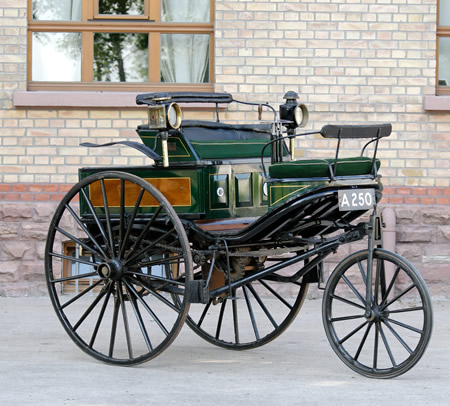
Photo: Evolution of Motor Car: The original Benz patent motor car of 1888 in the Dr. Carl Benz Automotive Museum in Ladenburg, Germany. (Photo © Daimler AG)
Thomas J. Donohue, President and CEO of the U.S. Chamber of Commerce, has issued the following statement on the U.S. Federal Administration's plan to restructure General Motors and the impending ruling on Chrysler:
"The future success of General Motors and Chrysler ultimately depends on whether they can profitably design and build cars that Americans and other consumers actually want to buy.
Our biggest concern with the restructuring plan announced today is the potential for governments and unions to influence production, product, workforce, and management decisions in ways that could jeopardize the automakers' chances for survival, put politics and special interests above sound business strategy, and disrupt our nation's trading relationships across the world.
For example, the UAW has said that it pressured GM to change where the company plans to produce a new line of smaller cars. And as part of the GM restructuring, the administration has reportedly closed the U.S. market to Opel and blocked Opel's forays into China so it could not compete with GM -- clear examples of market manipulation and protectionism.
If members of Congress, along with government officials from the United States to Germany to Canada, are allowed undue influence over management's decisions, then you can write this down: These companies will not return to profitability and their survival will be seriously challenged. The global talent that exists in the automotive sector must be allowed to do its job and be paid on a competitive basis. Management must be permitted to make tough decisions in a competitive global market without political interference.
So going forward, the U.S. Chamber will carefully monitor the activities of the new GM and Chrysler boards, and we will expose and fight any counterproductive influence by government, unions, or politicians over decisions that should be left to management. And we will continually insist that government reduce and eliminate its ownership stake as soon as possible."
(The U.S. Chamber is the world's largest business federation representing more than 3 million businesses and organizations of every size, sector, and region.)
Source: U.S. Chamber of Commerce
|GlobalGiants.com|
Edited & Posted by the Editor | 2:39 PM | View the original post
Global Light Vehicle Sales to Decline 15% in 2009, says Polk Study.
Study shows worldwide volumes won't return to pre-crisis levels until 2012.

R. L. Polk & Co.'s latest market study released today predicts that the automotive market won't emerge from the worldwide recession until 2012, later than previously forecast, due to worsening economic conditions. The study further predicts that Global light vehicle sales will decline 14.7 percent from 2008 levels to 55.2 million units in 2009.
Key Findings:
• Emerging Markets Have Greatest Growth Potential
• Asian Automakers Gain Market Share in U.S.
• Scrappage and Tax Incentives Provide Short-Term Help for Saturated Markets
• Toyota Maintains Position as the Top Manufacturer
Long-term growth for the global automotive market will come from the "emerging" markets of Latin America; Central and Eastern Europe; Africa and the fast-growing Asia-Pacific/Middle Eastern region (excluding the developed market of Japan). Beginning in 2015, Polk expects more light vehicles will be sold in the aggregated emerging markets than in the combined "saturated" markets of the United States, Canada, Western Europe and Japan.

"We see China and India as key drivers of growth, as vehicles become attainable for an increasing percentage of these countries' huge consumer populations," said Uwe Biastoch, director of global forecasting at Polk. "Like Tata Motors with the recent launch of the low-cost Nano in India, manufacturers that innovate and produce market-specific products will be successful in emerging markets," said Biastoch.
These emerging markets will come out of the current crisis three years earlier than the saturated regions. Light vehicle sales in the emerging markets will top 2007 levels in 2011; this won't happen until 2014 in the saturated regions.


The U.S. has been hard-hit by the economic crisis, and new vehicle sales have dropped from a high of almost 17.5 million in 2000 to 13.2 million in 2008, with a further decline to 10 million projected for 2009. Polk predicts that 2009 will mark the end of U.S. market share dominance for the domestic automakers: Asian manufacturers will capture 47 percent of U.S. market share, compared to 44 percent for American automakers and 9 percent for European brands.
Western Europe will fare better than the United States and Canada in the short term, in large part because of scrappage incentives introduced in countries including Germany and Italy. Light vehicle sales in Western Europe will fall 9 percent from 2008 to 2009, compared to 24 percent in the United States and Canada during the same timeframe.
"The U.S. market is currently in a state of flux, with the impact of Chrysler's Chapter 11 filing yet to be realized and GM's fate uncertain. It also remains to be seen whether the Obama administration will follow the lead of some European countries and reward consumers who turn in old vehicles and purchase cleaner cars, and what the impact of such a fleet modernization initiative might be," said Ulrich Winzen, chief analyst at Polk.
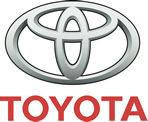

Worldwide, Toyota will maintain its position as the top manufacturer, with a fairly stable market share of 12 percent through 2020. Ford and General Motors have both seen their global market share drop by nearly five percentage points from 2000 to 2008, and Polk expects both to lose more market share through 2012. Volkswagen, on the other hand, will gain almost a point of market share in the next three years. "Volkswagen is making great inroads in China, which will certainly boost its success worldwide. At some point in 2009, we expect Volkswagen to surpass GM as the number two manufacturer in the world, although the race will be close," said Biastoch. "The trend could change temporarily to GM's benefit if the proposed U.S. scrappage incentive passes."
R. L. Polk & Co. is a provider of automotive information concerned with marketing.
Source: R. L. Polk & Co.
|GlobalGiants.com|
Click HERE for a PDF copy of the Polk's Market Study: "Forecasting Global Vehicle Demand".
Edited & Posted by the Editor | 4:49 AM | View the original post
Center director Jeffrey Cole: "greatest opportunities in their existence" await newspapers that can move decisively online.

According to the annual survey conducted by the Center for the Digital Future at USC's Annenberg School for Communication, in a year when the woes of newspapers -- layoffs, consolidations, and outright closings -- are more extensive than in any period in memory, strong evidence of the changing nature of media use in America may be found in a single statistic: Internet users report a large increase in time reading online newspapers.
In questions about reading online and print newspapers -- key elements of the eighth annual comprehensive study of the impact of online technology on America -- the Digital Future Project found that Internet users read online newspapers for 53 minutes per week, the highest level thus far in the Digital Future studies.
In contrast, Internet users in 2007 reported 41 minutes per week reading online newspapers.
The Digital Future Project also found that 22 percent of users said they stopped their subscription to a printed newspaper or magazine because they could access the same content while online.
"The most significant trend about how Americans are changing their news reading habits may be found in comparing the use of online media by light users vs. heavy users," said Center director Jeffrey I. Cole. "Heavy Internet users spent 65 more minutes per week reading online newspapers than do light users.
"This raises the question: how will the media habits of the current generation of light users change as online content continues to expand?" Cole said. "What ramifications will these changes have for the newspapers of America?"

"We're clearly now seeing a path to the end of the printed daily newspapers -- a trend that is escalating much faster than we had anticipated," Cole said. "The decline of newspapers is happening at a pace they never could have anticipated. Their cushion is gone, and only those papers that can move decisively to the Web will survive."
Cole cited four primary reasons for the rapid decline of printed newspapers: the loss of newspaper classified advertising to the digital realm, concerns about the environmental impact of newspapers, the economic downturn, and no prospects for new readers.
"With classified ads all but gone, newspapers had two major types of advertisers: car dealers and department stores," Cole said. "Those advertisers are withering away."
The findings are not unique to the United States. The World Internet Project, created by the Center for the Digital Future, conducts studies of the impact of online technology in 23 partner countries. Every partner has found the same trend in its country: when Internet use reaches 30 percent of the population, newspaper use begins to decline.
"Thirty years ago, teenagers began to read newspapers as they reached their adult years. Today, teenagers don't read printed newspapers, and research indicates they never will," Cole said. "Yet we've found that teens are more interested in news than any generation we've seen in a long time, only now online sites are their news sources.
"Our study has shown over the years that the future is clear," said Cole. "When newspaper readers die, they aren't being replaced by new readers."

• Opportunities for Newspapers
In spite of grim prospects, significant bright spots remain for newspapers, Cole said, including "the greatest opportunities in their existence."
"For the first time in 60 years, newsepaprs are back in the breaking news business," Cole said, "except now their delivery method is electronic and not paper."
"Since the beginning of radio, newspapers have not been able to compete with broadcasting for delivery of immediate news," said Cole. "But in a digital world, newspapers can compete at least as effectively for breaking news delivery with broadcast media. On the Web, newspapers are live, and they can supplement their coverage with audio, video, and the invaluable resources of their vast archives. And, they already have talented teams of reporters and editors who can deliver the news."
"The key to newspapers' success," said Cole, "will be making bold moves entirely into the digital realm, and building business models that allow them to thrive online."
In addition, print newspapers still have strong brand identities and reader loyalty, suggesting they may not be finished yet.
In fact, while the Digital Future Project found increased reading of media content online, the study also found that a large percentage of Internet users remain loyal to print versions of newspapers. When asked if they would miss the print edition of their newspaper if it were no longer available, 61 percent those who read newspapers offline agreed -- up from 56 percent in 2007.
The Center for the Digital Future at the USC (University of Southern California) Annenberg School for Communication created and organizes the World Internet Project, which includes the Digital Future Project and similar studies in North America, South America, Europe, Asia, the Middle East, and Oceania. Since 2000, the Digital Future Project has examined the influence of the Internet and online technology on Americans.
Source: The Center for the Digital Future
|GlobalGiants.com|
"You can never get all the facts from just one newspaper, and unless you have all the facts, you cannot make proper judgements about what is going on."
-- Harry S. Truman
Edited & Posted by the Editor | 1:37 PM | View the original post

According to Nieman Journalism Lab at Harvard University, the three newspapers honored by the Pulitzer Prize Board for breaking news all shared a common thread: They used the Web as their primary outlet, not ink-on-paper.
The New York Times -- which won the prize -- and finalists the Houston Chronicle and the St. Louis Post-Dispatch each shifted to a web-first mentality when faced with big breaking news. That was true whether the news was a prostitution scandal (Times), a hurricane (Chronicle), or a shooting (Post-Dispatch).
"We cover news any way people need news," Chronicle editor Jeff Cohen told the Nieman Journalism Lab at Harvard. "We cover it online, analog, digital, straight media -- any way you can serve it up, our staff is serving it up."


"The Internet has brought forth an unprecedented flowering of news and information," explains the Harvard Lab. "But it has also destabilized the old business models that have supported quality journalism for decades. Good journalists across the country are losing their jobs or adjusting to a radically new news environment online. We want to highlight attempts at innovation and figure out what makes them succeed or fail. We want to find good ideas for others to steal. We want to help reporters and editors adjust to their online labors; we want to help traditional news organizations find a way to survive; we want to help the new crop of startups that will complement -- or supplant -- them."
The Nieman Journalism Lab is a project at Harvard University to figure out the future of quality journalism online.
Source: Nieman Journalism Lab
|GlobalGiants.com|
"I am deeply interested in the progress and elevation of journalism, having spent my life in that profession, regarding it as a noble profession and one of unequaled importance for its influence upon the minds and morals of the people."
-- Joseph Pulitzer
"Journalism is popular, but it is popular mainly as fiction. Life is one world, and life seen in the newspapers is another."
-- Gilbert K. Chesterton
Edited & Posted by the Editor | 6:06 AM | View the original post
Hundreds of Thousands of People to Celebrate Music, Art and Culture.

Photo: More than 3,000 Native American dancers dressed in colorful outfits adorned with feathers, bells, jingles and fringes enter the University of New Mexico University Arena (known as "The PIT") as part of the "Grand Entry" for the world's largest gathering of Native American and indigenous people at the 26th Annual Gathering of Nations held in Albuquerque, NM between April 23 and 25, 2009.
The world's largest gathering of Native American and indigenous people will take place in Albuquerque, New Mexico, USA, between April 23 and 25, 2009 at The 26th Annual Gathering of Nations, the most prominent Native American powwow in the world. The event will be held at the University of New Mexico's University Arena (known locally as "The Pit") and will host more than 150,000 people and more than 500 tribes from throughout the United States and around the world celebrating their culture and traditions.
The Gathering of Nations' three-day event will include 36 different indigenous bands performing in an amphitheatre. The musical genres include country, reggae, rhythm and blues, hip-hop, rock 'n' roll, and more. In addition, more than 3,000 Native American singers and dancers will be entertaining a capacity crowd, and more than 600 Native American artisans, craftsmen and traders will be displaying and selling their work.
As part of the Gathering of Nations, a young Native American woman will be crowned Miss Indian World and represent all native and indigenous peoples as a cultural goodwill ambassador. Twenty-six Native American women representing their different tribes and traditions will compete for the title in the areas of tribal knowledge, dancing ability, and personality assessment.
The "Grand Entry" begins at noon on Friday, April 24 with more than 3,000 Native American dancers dressed in colorful outfits adorned with feathers, bells, jingles, and fringes enter the arena to the sounds of hundreds of drums beating simultaneously.
Source: Gathering of Nations
|GlobalGiants.com|
Edited & Posted by the Editor | 11:49 AM | View the original post
Proceeds from Online Auction to be Donated to the Jenesse Center.

Photo: Bracelet featured in Halle Berry fragrance ad to be auctioned off for charity.
Academy Award-winning actress and beauty icon Halle Berry will auction off a unique, hand-carved rose gold cuff bracelet this week to show her support for families dealing with the devastating effects of domestic violence. As of April 15th, consumers can place bids through CharityBuzz.com for the chance to own this signature piece. The cuff bracelet was designed exclusively for Halle Berry to wear in the advertising campaign for her debut fragrance, Halle by Halle Berry. Net proceeds generated by the auction will be donated to the Jenesse Center, a domestic violence intervention program.
Designed by Gara Danielle, this stunning cuff bracelet was inspired by Halle Berry's natural beauty and was designed specifically for Halle to wear on set at the making of her fragrance campaign in Ohahu, Hawaii. Now anyone can have the opportunity to own a replica of the bracelet and support this cause by bidding on charitybuzz.com. Made from 14K rose gold plate over sterling silver, this adjustable cuff is valued at $4,000.
The Jenesse Center is a non-profit organization that was founded in 1980 and provides help to victims of domestic violence with a comprehensive centralized base of support through facilities, education and health programs, case management, and legal services.
Source: Coty Beauty
|GlobalGiants.com|
Edited & Posted by the Editor | 10:04 AM | View the original post
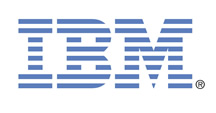

According to a study released today by IBM (NYSE:IBM) , increasing demand on rail systems in the U.S. and around the world will dramatically strain existing rail infrastructure. The study, "The Smarter Railroad," analyzes new approaches to modernize and build high-speed rail networks globally, such as those announced today by President Obama.
Findings from the report indicate that the top key challenges in the development of better rail systems, cited by the world's leading global rail executives, were capacity and congestion; operational efficiency and reliability; structural and competitive issues; and safety and security. The report also highlights emerging technologies that will help rail companies better instrument, analyze and manage rail networks and equipment in real-time.

"The global rail industry in 2009 and beyond will struggle to meet the increasing demand for freight and passenger transportation, while aging systems and infrastructure complicate the problem," says Keith Dierkx, Director, IBM Global Rail Programs. "However, rail companies around the world are starting to apply new technologies that will help them build high-speed rail systems that more efficiently move people, are more cost effective, and make more intelligent use of all rail assets, from tracks to trains. IBM is already working with railroads to build these smarter systems around the world."
Data indicates that US$300 billion will be spent globally to upgrade, expand and initiate railway networks during the next five years. These investments are designed to build a new rail infrastructure that can meet dramatically increasing rail capacity demand over the next two decades. Even meeting current demand requires that nearly 40 cents on every revenue dollar is spent maintaining the rail system.

IBM developed this report to help governments and railroad companies better understand and address the challenges facing both passenger and freight rail systems. Building these modern railroad systems requires information to be shared across the rail network and among many different stakeholders, including the rail company, shippers, car owners, travel agents, municipalities, intermodal carriers and customers.
IBM says that it is building intelligent transportation systems around the world to help cities manage traffic congestion, improve urban environmental conditions and increase economic competitiveness. These systems leverage business consulting, advanced transportation analytics, Research, supercomputing and new sensor networks. These projects include smart transportation initiatives in China, The Netherlands, Stockholm, Brisbane, Singapore, Dublin, London and other locations around the world.

According to IBM, its smart rail projects involve software and services designed to collect and analyze data gathered from devices on trains, tracks, stations and other assets to improve the speed, safety, and reliability of rail service. IBM adds that, for example, Netherlands Railways, one of the busiest national railway networks in Europe, is using IBM software to manage more than 5,000 trains in the Netherlands through a network of 390 stations and 2,800 kilometers of track.
"The smart transportation system improves the on-time performance for more than one million passengers each day by more accurately matching the number of trains in service to expected user traffic. Netherlands Railways has been able to improve its operating efficiency by as much as six percent, netting the railway a cost savings of over euro 20 million annually," IBM explains.
Source: IBM
|GlobalGiants.com|
Edited & Posted by the Editor | 1:32 PM | View the original post

The Conference Board reports that global output growth in 2009 will be slow but remains positive at 1.3% for 2009. As the G-20 gathers in London, The Conference Board points at large discrepancies in the global economy this year, with advanced economies experiencing a strong contraction in output at -2.5% on average, and emerging economies pulling the world economy along at a reasonable pace of 5.0% on average.
"As projections of global growth have been slashed dramatically recently, we need to remain conscious of the huge uncertainties about how the decline in global trade affects the domestic sectors of emerging economies," says Bart van Ark, Vice President and Chief Economist of The Conference Board. "The internal dynamics of growth created by the millions of consumers in these countries, who have a job or are able to find a job, even in a slowing economy, will continue to generate positive growth." His analysis appears in StraightTalk, a newsletter designed exclusively for members of The Conference Board global business network.

MODEST RECOVERY IN THE U.S. REMAINS LIKELY
Real GDP in the United States is forecasted to fall by -5.9% on an annual rate during the first quarter of 2009, signaling a deep point in the recession. Some better numbers are beginning to emerge. The Conference Board Leading Economic Index and Consumer Confidence Index suggest that the recession will not intensify further. The decline in real consumer spending has leveled off a little. Retail sales, excluding cars and car parts, rose by .7% in February, and some turns in the measures of home sales and prices were also recorded. The Conference Board projects that growth in the second quarter will stay negative and will be very slow in the third quarter, as capital spending will remain low and inventories will not be depleted until year's end. Overall industrial production is also unlikely to move up before the fall. Even the recovery in the fourth quarter will be held back by these negative trends and increased unemployment, which is typically a lagging indicator.
The U.S. may see a contraction in real GDP of -2.6% in 2009 - the largest annual decline since 1946. Nominal output (the value of output that also reflects price change) may actually fall at more than 4%, as disinflation is much more likely in the short run than inflation.
RISK OF A "DOUBLE-DIP" RECESSION
Back-to-back recessions, as occurred between 1980 and 1982 when the economy endured a systemic crisis rather than a regular recessionary period, are a potential risk at this time. Recent increases in commodity prices, on the back of monetary easing and decline in the dollar, are leading to an increase in inflation expectations.
"If the United States experiences a too rapid recovery, there may be a risk of another recession in 2010," cautions Van Ark. "It may fuel expectations for a return to inflation, adding to the uncertainty concerning the pattern and path of economic recovery."
The likelihood of this happening is small as there are three substantial differences between the current crisis and that of the early 1980s: 1) Inflation was the concern then; now the possibility of deflation for the short and medium term is a greater threat. 2) The 1980s crisis was related to a structural transformation of the model of production in the U.S., moving from a manufacturing to a services economy; the current crisis was largely sparked by overleveraged balance sheets and global imbalances in consumption and savings. 3) This time we have massive governmental intervention intended to prevent economic activity from declining even further and stem the rise in unemployment.

LARGE DISCREPANCIES BETWEEN ADVANCED AND EMERGING ECONOMIES
The Conference Board argues that the divergence in growth performance between advanced and emerging economies will create a major challenge to rebalancing the world economy toward a more manageable global distribution of production, consumption and trade in goods and services.
The economies of commodity-producing countries - such as Russia and Brazil - have been producing bad results due to falling energy and commodity prices. China and India are the best bets to limit the global output collapse in 2009. China's export growth engine is under serious stress and the consumer sector will surely be affected by the decline in employment opportunities.
But the internal dynamics of growth created by the millions of consumers who still have a job or are able to find one in a slowing economy will continue to generate positive growth in China. Even though much of the U.S. $586 billion stimulus is likely to have already been baked into the government's investment plans, it may help keep China's growth rate at about 7.5% for 2009, says van Ark.
In India, as well as in several other large economies in the developing world that are somewhat less exposed to the global storm, the impact of the collapse in financial markets on fourth quarter GDP may have done a less lasting damage to the potential for growth this year.
Source: The Conference Board
|GlobalGiants.com|
Edited & Posted by the Editor | 11:38 AM | View the original post

With nuclear weapons high on the agenda for the historic first Obama-Medvedev meeting, more than 100 international leaders on the forefront of the Global Zero initiative are urging the U.S. and Russian presidents to work toward dramatic reductions of U.S. and Russian nuclear arsenals and then to lead a longer-term effort to eliminate nuclear weapons worldwide. These leaders said that because American and Russian stockpiles account for 96 percent of the world's nuclear weapons, the U.S. and Russia should begin with deep reductions to their arsenals, while beginning a dialogue with the other nuclear weapons states. The group believes that a commitment by nuclear powers to begin serious negotiations for global zero would strengthen the case against any non-nuclear nation which strives to acquire nuclear weapons and would set the stage for the first ever multilateral negotiation on nuclear reductions.

In addition to leaders from other key countries, the group is comprised of distinguished American and Russian leaders, including former U.S. Senator Chuck Hagel; Ambassador Richard Burt, former U.S. Chief Negotiator in Strategic Arms Reduction Talks; Gen. (Ret.) Jack Sheehan, Commander-in-Chief, U.S. Atlantic Command; former U.S. Secretary of State Lawrence Eagleburger; former U.S. Secretary of Defense Frank Carlucci; former U.S. National Security Advisor, Dr. Anthony Lake; former U.S. Ambassador to Russia Tom Pickering; former Russian Foreign Minister Igor Ivanov; former Soviet Union Foreign Minister Alexander Bessmertnykh; Col. Gen. (Ret.) Yevgeny Maslin, former Chief of the Main Directorate, Russian Ministry of Defense; Dr. Evgeny Velikhov, President, Kurchatov Institute; and Mr. Igor Yurgens, Chairman of the Institute of Contemporary Development (of which Russian President Medvedev is the Chairman of the Board of Trustees).
The Obama-Medvedev meeting is occuring in London on April 1, just before the kickoff of the G-20 meeting there.

Former U.S. Senator Chuck Hagel said this week, "We are urging the two presidents to seize this historic opportunity to confront the most urgent security threat to our world: the proliferation of nuclear weapons and the related risk of nuclear terrorism. The two leaders can move beyond traditional arms control and, in a bold move, set the world on a course toward the total elimination of all nuclear weapons -- global zero. This will not happen quickly, easily nor unilaterally. Getting to global zero will require the reduction of all nations' nuclear arsenals over many years. It is important to begin now, and set the world on a new course."
Former Russian Foreign Minister Igor Ivanov said, "A far-reaching joint initiative by Presidents Medvedev and Obama in favor of nuclear weapons non-proliferation and nuclear arms limitations brings the problem to the top of the contemporary international policy agenda. It would set the stage for multiplying efforts in the nuclear disarmament and arms limitations area at the bilateral, regional and global levels, for strengthening the nuclear weapons non-proliferation regime, and for a constructive outcome of the 2010 Non-Proliferation Treaty Review Conference. Constructive and long-term cooperation between Russia and the U.S., who possess more than 90 percent of the world's nuclear weapons, is crucial for nuclear non-proliferation and nuclear weapons reductions. However, that process should not be limited to Russian-American efforts. The other nuclear states should contribute to that as well. That kind of interaction predetermines success of international efforts for building up the international security of the 21 Century and moving toward the world free of nuclear weapons."
Global Zero is a new worldwide, nonpartisan initiative spearheaded by more than 100 international leaders working for a binding, verifiable agreement to eliminate all nuclear weapons. The group includes nine former heads of state; eight former foreign ministers from the United States, Russia, Britain and India; three former defense ministers from the United States and Britain; six former national security advisors from the United States, India and Pakistan; and nineteen former top military commanders from the United States, Russia, China, Britain, India and Pakistan. Global Zero is forming an international commission of prominent political and military leaders and policy experts from key countries that will be unveiled in the coming weeks. With a clear, realistic and pragmatic appreciation of the challenges of achieving the goal, this distinguished commission will develop a detailed step-by-step action plan for getting to zero nuclear weapons.
In early March, Sen. Hagel and Amb. Burt met with President Medvedev in Moscow, where eliminating nuclear weapons was discussed. Sen. Hagel and Amb. Burt have given letters to Presidents Obama and Medvedev, co-signed by more than 90 Global Zero leaders, urging bold action toward eliminating nuclear weapons.
Last July, then-candidate Barack Obama said, "It is time to ... stop the spread of nuclear weapons; and to reduce the arsenals from another era. This is the moment to begin the work of seeking the peace of a world without nuclear weapons." This month, President Medvedev declared that his country "... is fully committed to reaching the goal of a world free from these most deadly weapons."
Source: Global Zero
|GlobalGiants.com|
"I do not know with what weapons World War III will be fought, but World War IV will be fought with sticks and stones. "
-- Albert Einstein
"And he shall judge among the nations, and shall rebuke many people: and they shall beat their swords into plowshares, and their spears into pruninghooks: nation shall not lift up sword against nation, neither shall they learn war any more...
The wolf also shall dwell with the lamb, and the leopard shall lie down with the kid; and the calf and the young lion and the fatling together; and a little child shall lead them."
-- Isaiah 2:4, 11:6
Edited & Posted by the Editor | 9:39 AM | View the original post
But Many Companies Still Have a Long Way to Go in Protecting Their Reputations.

According to a new report from The Conference Board (global business research and membership organization), a growing number of major global companies are investing substantial resources to manage their reputation risk and have increased their efforts to do so over the last three years.
"Safeguarding reputation is even more critical today because companies have developed successful ways to make reputation risk management part of their overall risk management," says Ellen Hexter, Director, Enterprise Risk Management at The Conference Board and co-author of the report with Sandy Bayer, President of Bayer Consulting. "In addition, different stakeholder groups are becoming more sophisticated in how they drive corporate reputations. Critics on the Internet can now transmit their opinions and complaints around the world with ease. Most importantly, consumers have high expectations that companies will not only produce quality products and services, but also will act ethically in their creation and distribution."
The report defines reputation as how a company is perceived by each of its stakeholder groups and reputation risk as the risk that an event will negatively influence stakeholder perceptions. Many reputation risks are the secondary result of other, more traditionally recognized risks. For example, if a manufacturer produces an unsafe product, it may lose customers and is likely to suffer financial costs due to a product recall, both of which impact reputation. Reputations may be damaged for any number of reasons, including that stakeholders perceive a company to be unethical.

"Although reputation is the quintessential intangible asset, a strong corporate reputation yields concrete benefits - higher market value, stronger sales, and an increased ability to hire the best and the brightest," says Bayer.
The report is based on the findings of The Conference Board Reputation Risk Research Working Group and a survey of 148 risk management executives of major corporations. More than three quarters of the respondents to the survey said their companies are making a substantial effort to manage reputation risk (82 percent) and they have increased focus in this area over the last three years (81 percent).
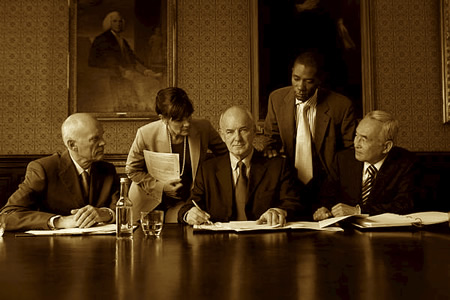
Other key findings of the study:
• Reputation risk should be managed throughout the organization. Although communication is of critical importance in responding to a risk event, a company's reputation should be considered during the preparation and execution of strategy and new projects, which hasn't been the case in most companies.
• Reputation risk is often not incorporated into risk management. Only 49 percent of executives surveyed said that the management of reputation risk was highly integrated with their Enterprise Risk Management (ERM) function or another risk oversight program.
• Assessing reputation risks is a top challenge. Fifty-nine percent indicated that assessing the perceptions and concerns of stakeholders was an extremely or very significant issue, making it the highest-ranked challenge.
• Media monitoring has become more sophisticated. Today, there are tools to assess whether coverage is positive, neutral or negative; the credibility of publications; the prominence of coverage, etc.
• Efforts are being made to quantify the value of reputation. A select group of companies is making progress in this area by working with specialist consulting firms to quantify the impact of reputation on share price.
• Social media are gaining influence, but most companies are ignoring them. Although consumers and investors are increasingly gathering information from blogs, online forums, and social networking sites, only 34 percent of the survey respondents said they extensively monitor such sites, and only 10 percent actively participated in them.

The findings spurred the following recommendations from The Conference Board Research Working Group:
1) Actively involve boards of directors in reputation risk management.
2) Demonstrate to leaders and management teams in business units the impact of their actions on reputation.
3) Integrate reputation risk management with ERM or other risk management programs.
4) Quantify the value of reputation.
5) Use and nurture employees as corporate ambassadors.
"Boards of directors, senior management, and operating management should demonstrate an active commitment to strong reputation management," conclude the authors.
Source: The Conference Board
|GlobalGiants.com|
"Our reputation is more important than the last hundred million dollars."
-- Rupert Murdoch
"From the sublime to the ridiculous there is but one step."
-- Napoleon Bonaparte
Edited & Posted by the Editor | 12:59 AM | View the original post
Steps to Financial Cataclysm Paved with Industry Dollars?

The financial sector invested more than $5 billion in political influence purchasing in Washington over the past decade, with as many as 3,000 lobbyists winning deregulation and other policy decisions that led directly to the current financial collapse, according to a 231-page report issued today by Essential Information and the Consumer Education Foundation.
The report, "Sold Out: How Wall Street and Washington Betrayed America," shows that, from 1998-2008, Wall Street investment firms, commercial banks, hedge funds, real estate companies and insurance conglomerates made $1.725 billion in political contributions and spent another $3.4 billion on lobbyists, a financial juggernaut aimed at undercutting federal regulation. Nearly 3,000 officially registered federal lobbyists worked for the industry in 2007 alone. The report documents a dozen distinct deregulatory moves that, together, led to the financial meltdown. These include prohibitions on regulating financial derivatives; the repeal of regulatory barriers between commercial banks and investment banks; a voluntary regulation scheme for big investment banks; and federal refusal to act to stop predatory subprime lending.
"The report details, step-by-step, how Washington systematically sold out to Wall Street," says Harvey Rosenfield, president of the Consumer Education Foundation, a California-based non-profit organization. "Depression-era programs that would have prevented the financial meltdown that began last year were dismantled, and the warnings of those who foresaw disaster were drowned in an ocean of political money. Americans were betrayed, and we are paying a high price -- trillions of dollars -- for that betrayal."
"Congress and the Executive Branch," says Robert Weissman of Essential Information and the lead author of the report, "responded to the legal bribes from the financial sector, rolling back common-sense standards, barring honest regulators from issuing rules to address emerging problems and trashing enforcement efforts. The progressive erosion of regulatory restraining walls led to a flood of bad loans, and a tsunami of bad bets based on those bad loans. Now, there is wreckage across the financial landscape."

12 Key Policy Decisions Led to Cataclysm
The report concludes that financial deregulation led directly to the current economic meltdown. For the last three decades, government regulators, Congress and the executive branch, on a bipartisan basis, steadily eroded the regulatory system that restrained the financial sector from acting on its own worst tendencies. "Sold Out" details a dozen key steps to financial meltdown, revealing how industry pressure led to these deregulatory moves and their consequences:
1. 1. In 1999, Congress repealed the Glass-Steagall Act, which had prohibited the merger of commercial banking and investment banking.
2. Regulatory rules permitted off-balance sheet accounting -- tricks that enabled banks to hide their liabilities.
3. The Clinton administration blocked the Commodity Futures Trading Commission from regulating financial derivatives -- which became the basis for massive speculation.
4. Congress in 2000 prohibited regulation of financial derivatives when it passed the Commodity Futures Modernization Act.
5. The Securities and Exchange Commission in 2004 adopted a voluntary regulation scheme for investment banks that enabled them to incur much higher levels of debt.
6. Rules adopted by global regulators at the behest of the financial industry would enable commercial banks to determine their own capital reserve requirements, based on their internal "risk-assessment models."
7. Federal regulators refused to block widespread predatory lending practices earlier in this decade, failing to either issue appropriate regulations or even enforce existing ones.
8. Federal bank regulators claimed the power to supersede state consumer protection laws that could have diminished predatory lending and other abusive practices.
9. Federal rules prevent victims of abusive loans from suing firms that bought their loans from the banks that issued the original loan.
10. Fannie Mae and Freddie Mac expanded beyond their traditional scope of business and entered the subprime market, ultimately costing taxpayers hundreds of billions of dollars.
11. The abandonment of antitrust and related regulatory principles enabled the creation of too-big-to-fail megabanks, which engaged in much riskier practices than smaller banks.
12. Beset by conflicts of interest, private credit rating companies incorrectly assessed the quality of mortgage-backed securities; a 2006 law handcuffed the SEC from properly regulating the firms.
Financial Sector Political Money and 3000 Lobbyists Dictated Washington Policy
During the period 1998-2008:
• Commercial banks spent more than $154 million on campaign contributions, while investing $363 million in officially registered lobbying:
• Accounting firms spent $68 million on campaign contributions and $115 million on lobbying;
• Insurance companies donated more than $218 million and spent more than $1.1 billion on lobbying;
• Securities firms invested more than $504 million in campaign contributions, and an additional $576 million in lobbying. Included in this total: private equity firms contributed $56 million to federal candidates and spent $33 million on lobbying; and hedge funds spent $32 million on campaign contributions (about half in the 2008 election cycle).
The betrayal was bipartisan: about 55 percent of the political donations went to Republicans and 45 percent to Democrats, primarily reflecting the balance of power over the decade. Democrats took just more than half of the financial sector's 2008 election cycle contributions, the report clarifies.
According to the report, the financial sector buttressed its political strength by placing Wall Street expatriates in top regulatory positions, including the post of Treasury Secretary held by two former Goldman Sachs chairs, Robert Rubin and Henry Paulson.
Financial firms employed a legion of lobbyists, maintaining nearly 3,000 separate lobbyists in 2007 alone, says the report.
These companies drew heavily from government in choosing their lobbyists. Surveying 20 leading financial firms, "Sold Out" finds 142 of the lobbyists they employed from 1998-2008 were previously high-ranking officials or employees in the Executive Branch or Congress.
Essential Information is a Washington, D.C. nonprofit that seeks to curb excessive corporate power. The Consumer Education Foundation is a California-based nonprofit that supports measures to prevent losses to consumers.
Source: Essential Information
|GlobalGiants.com|
Click HERE for a full PDF copy of "Sold Out: How Wall Street and Washington Betrayed America".
"Information is the currency of democracy."
-- Thomas Jefferson
"As a very important source of strength and security, cherish public credit. One method of preserving it is, to use it as sparingly as possible; avoiding occasions of expense by cultivating peace, but remembering also that timely disbursements to prepare for danger frequently prevent much greater disbursements to repel it; avoiding likewise the accumulation of debt, not only by shunning occasions of expense, but by vigorous exertions in time of peace to discharge the debts, which unavoidable wars may have occasioned, not ungenerously throwing upon posterity the burthen, which we ourselves ought to bear."
-- GEORGE WASHINGTON, Farewell Address, Sep. 17, 1796
"The government, which was designed for the people, has got into the hands of the bosses and their employers, the special interests. An invisible empire has been set up above the forms of democracy."
-- Woodrow Wilson
"In politics... never retreat, never retract... never admit a mistake."
-- Napoleon Bonaparte
Edited & Posted by the Editor | 5:56 AM | View the original post
Automaker Report Cards: Honda Leads Again, Mercedes-Benz Improves, Chrysler Lags.
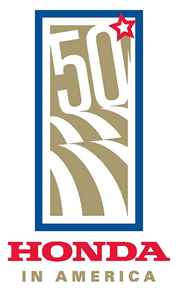
For the third consecutive year, Honda has earned class leader status for building the best all-around vehicles for American drivers, according to the Automaker Report Cards published in Consumer Reports' Annual Auto Issue. At the opposite end of the annual ranking is Chrysler, which fared even worse than last year. The company's poor performing products and sinking reliability results have kept all Chrysler, Dodge, and Jeep badged vehicles off CR's Recommended list.
With an overall score of 78 out of 100 points, Honda was followed closely by Subaru (75), and Toyota (74) in the overall score. Subaru is also the only automaker with 100% of its tested vehicles Recommended, although it has a relatively small model lineup. Mazda (73), came in 4th, followed by Mercedes-Benz, Nissan, Volkswagen, and BMW, all tied at 72.
While the top four overall scores belong to Japanese automakers, a Japanese nameplate is no guarantee that every car in a model range will be a reliable and good performer. For example, the Honda Element and Toyota Yaris scored too low in Consumer Reports' tests to be recommended. Conversely, despite overall scores of 63 and 57 respectively, that placed Ford and GM toward the bottom of the results, new models like the Ford Flex, F-150, Chevrolet Malibu, and Cadillac CTS have done well in CR's tests and rank near the top of their classes in its ratings.
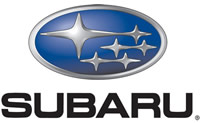
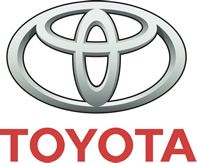

The overall score for each automaker is based on the average of its vehicles' overall scores in Consumer Reports' road tests and their average predicted-reliability ratings from Consumer Reports' Annual Auto Survey. Manufacturers received a report card only if five or more of its vehicles were tested.
Of the Asian automakers, Subaru, Nissan, Mazda, and Hyundai improved their overall scores. Nissan and Hyundai also improved their reliability rating. Of the four, Hyundai showed the most improvement, increasing its overall score from 66 to 70.
European automakers, traditionally great performers overall, have lagged in reliability but there have been notable improvements with several models from Audi, BMW, Saab, Volkswagen, Volvo, and Mercedes-Benz. Mercedes-Benz showed the most significant improvement, moving up in the overall ranking (72) to tie with BMW and Volkswagen.
"All three Detroit automakers continued to be at the back of the class, although General Motors and Ford improved their overall scores. Chrysler disappointed the most -- it had the lowest overall test score and none of its vehicles are Recommended," says Consumer Reports.

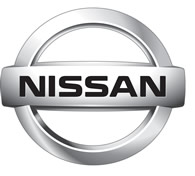
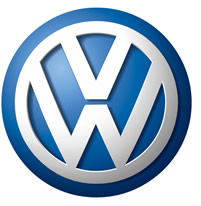
There was some positive news for the struggling U.S. domestic automakers. The latest models from General Motors now rank among the best in testing, and models like the Buick Enclave, Chevrolet Traverse, GMC Acadia, Saturn Outlook, Cadillac CTS, Chevrolet Corvette, and Chevrolet Malibu all scored well. Some Ford models now rival their competition from Honda and Toyota in reliability, perhaps a promising sign for new models now coming out of the product pipeline. For Chrysler, the sole glimmer of hope in the model-year is the new Dodge Ram, which is now very competitive with the other full size trucks.
"While Japanese automakers continue to set the standard for the industry in terms of real-world performance and reliability, many domestic, European, and Korean manufacturers are narrowing the gap by building better and more reliable cars," said David Champion, senior director of automotive testing, Consumer Reports. "While some automakers are still dragged down by old product investments, we expect the race for the front of the class to become even more competitive which may lead to some excellent values for consumers in the near future."
In the end, the companies that make the best vehicles are those that excel in performance, interior craftsmanship, safety, comfort, and reliability. The best continue to set a higher and higher standard, a competition in which consumers are the ultimate winners.
Consumer Reports is one of the trusted sources for information and advice on consumer products and services, and according to it, its findings may not be used for commercial or promotional purposes.
Source: Consumer Reports
|GlobalGiants.com|
"Can advertising foist an inferior product on the consumer? Bitter experience has taught me that it cannot. On those rare occasions when I have advertised products which consumer tests have found inferior to other products in the same field, the results have been disastrous."
-- David Ogilvy
Edited & Posted by the Editor | 11:04 PM | View the original post
Lexus Ranks Highest in Customer Satisfaction with Dealer Service.

In today's tough automotive market, providing consumers with superior service experiences translates into increased profitability for dealers and automakers, with the highest-performing brands retaining more than 80 percent of their customer maintenance and repair dollars within their dealer network, compared with retention rates of less than 60 percent for lower-performing brands, according to the J.D. Power and Associates 2009 Customer Service Index (CSI) Study released today.
The study, now in its 29th year, examines satisfaction among vehicle owners who visit a service department for maintenance or repair work. The CSI rankings are based on dealer performance during the first three years of ownership, which typically represent the majority of the vehicle warranty period. Five measures are examined to determine overall customer satisfaction with dealer service (listed in order of importance):
(1) Service Quality
(2) Service Initiation
(3) Service Advisor
(4) Service Facility
(5) Vehicle Pickup
![]()
The study finds that although satisfaction with dealer service tends to decline as vehicles age--particularly during the fourth and fifth years of ownership--those automakers whose dealers provide the highest levels of satisfaction during the warranty period retain a greater share of future service visits at the dealership, even after the warranty period expires. Brands with dealers that achieve particularly high CSI scores (800 or higher) during the first three years of vehicle ownership retained 79 percent of dollars spent on maintenance and repairs during the first five years of ownership. In contrast, brands that attained CSI scores below 800 retained only 69 percent of customer maintenance and repair dollars.
"Since dealer service is the last touch point in the vehicle ownership cycle that auto manufacturers have with customers, providing superior levels of service can leave owners with a lasting favorable impression of the brand," said Jon Osborn, research director at J.D. Power and Associates. "Providing excellent service is not only good for customers, but it also benefits dealers and automakers in terms of income from future service visits and sales. The significant decline in new-vehicle sales means that dealers are relying even more heavily on the service-operations side of their business for much-needed revenue. In many cases, this income is keeping the dealerships open. With the stakes so high, it is imperative for dealers to focus heavily on maximizing satisfaction levels."

Lexus ranks highest in customer satisfaction with dealer service in 2009--improving from fourth rank position in 2008. Lexus achieves an overall CSI score of 835 on a 1,000-point scale and performs particularly well in four of the five measures: service quality; service initiation; service advisor and service facility. Rounding out the top five nameplates are Jaguar (810), BMW (808), Cadillac (806) and Acura (805).
"The highest-performing brands differentiate themselves particularly in the service quality and service facility measures," said Osborn. "There are several practices that the highest-ranked brands consistently perform that help elevate customer service satisfaction levels, including providing prompt service appointments; greeting the customer immediately on arrival; knowing the vehicle's service history; returning vehicles to customers in a clean condition; and offering alternative transportation to customers leaving their cars for service. These courtesies may seem intuitive, but many dealers do not provide them consistently. We find that they are very effective in raising customer satisfaction, provided that the service work performed on the vehicle is also satisfactory."
The 2009 CSI Study is based on responses from 106,059 owners and lessees of 2004 to 2008 model-year vehicles. The study was fielded between October and December 2008. J.D. Power and Associates measures dealer service in various countries around the world, including Australia, Canada, China, France, Germany, India, Indonesia, Japan, Malaysia, Mexico, New Zealand, the Philippines, South Africa, Taiwan, Thailand and the UK.
Customer Satisfaction Index Ranking
(Based on a 1,000-point scale)
Lexus ---------- 835
Jaguar ---------- 810
BMW ---------- 808
Cadillac ---------- 806
Acura ---------- 805
HUMMER ---------- 804
Land Rover ---------- 803
Buick ---------- 802
Saturn ---------- 800
Lincoln ---------- 798
Porsche ---------- 792
Audi ---------- 789
Mercedes-Benz ---------- 789
Infiniti ---------- 786
SAAB ---------- 785
GMC ---------- 781
MINI ---------- 781
Pontiac ---------- 779
Chevrolet ---------- 777
Mercury ---------- 776
Mitsubishi ---------- 767
Volvo ---------- 767
Hyundai ---------- 763
Honda ---------- 762
Industry Average ---------- 761
Ford ---------- 757
Chrysler ---------- 746
Scion ---------- 739
Toyota ---------- 736
Dodge ---------- 734
Subaru ---------- 729
Jeep ---------- 727
Volkswagen ---------- 725
Kia ---------- 724
Nissan ---------- 723
Mazda ---------- 716
Suzuki ---------- 702
Source: J.D. Power and Associates
|GlobalGiants.com|
"It takes 20 years to build a reputation and five minutes to ruin it. If you think about that, you'll do things differently."
-- Warren Buffett
Edited & Posted by the Editor | 11:42 AM | View the original post
 |
 |
